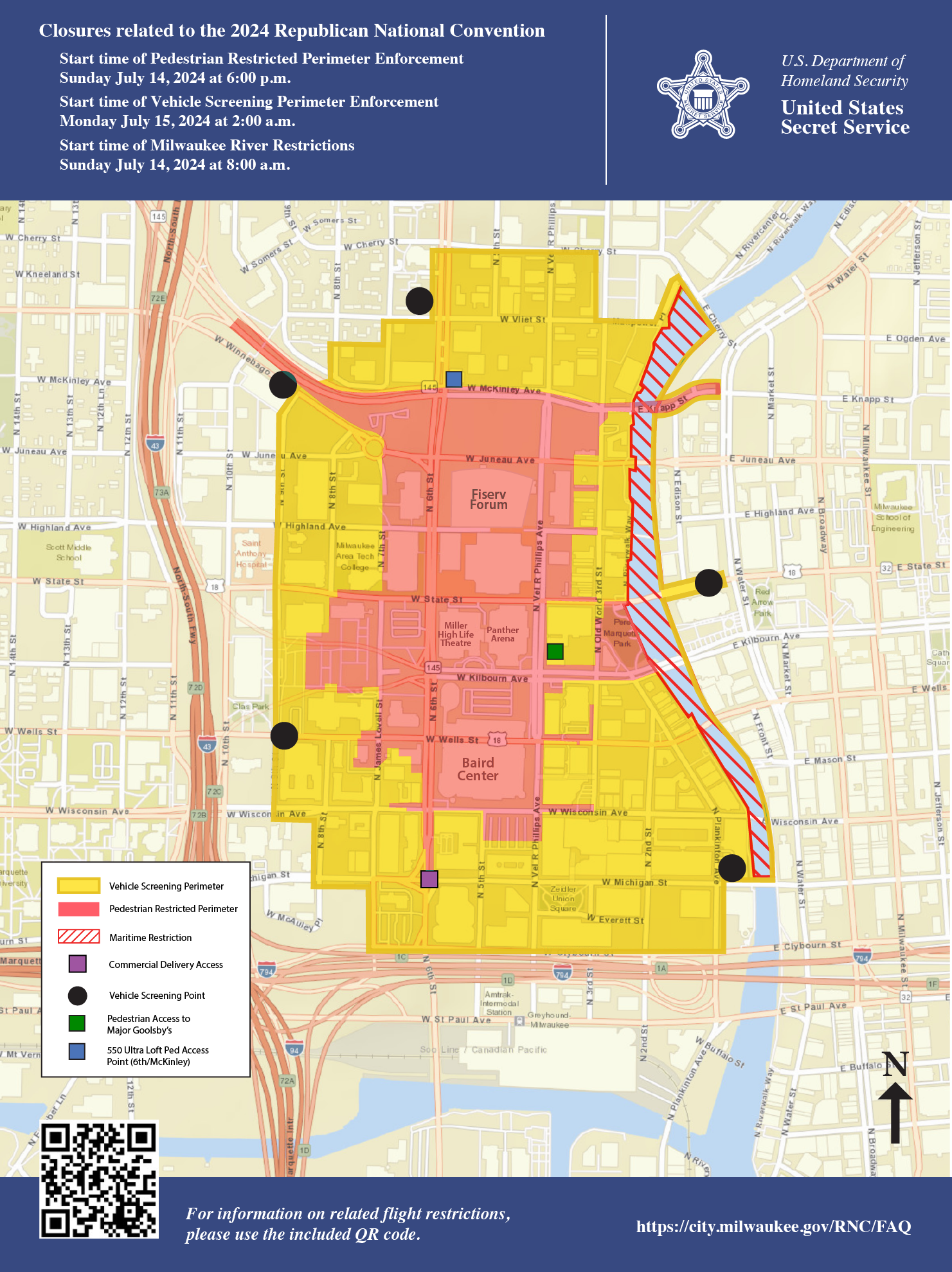As the 2024 Republican National Convention approaches, ensuring the safety of attendees, particularly high-profile figures such as a US Presidential candidate, is paramount. The current security plan, as depicted in the provided map, highlights fundamental aspects like perimeter controls and access restrictions. However, there are several critical deficiencies that need to be addressed to bolster security measures effectively. In this post, we will discuss these deficiencies and outline necessary enhancements, including the importance of implementing restricted airspace over the convention area.
1. Broad Perimeter Zones
Deficiency: The vehicle and pedestrian perimeters are extensive, potentially diluting the effectiveness of security measures across a large area. This broad coverage can overwhelm security personnel and allow for potential breaches due to the numerous access points needing constant monitoring.
Improvement: Implement multiple layers of security zones with escalating levels of screening and restrictions as one moves closer to the core event area. This layered approach creates a buffer, deterring and detecting potential threats more effectively.
2. Lack of Details on Surveillance
Deficiency: The map does not indicate the presence of surveillance systems such as CCTV coverage, drone monitoring, or other advanced surveillance technologies, which are crucial for real-time threat detection.
Improvement: Deploy advanced surveillance systems including high-resolution CCTVs, facial recognition technology, and drone patrols. Integrate these systems into a central command center for continuous observation and rapid response.
3. Insufficient Checkpoints
Deficiency: While vehicle screening points and pedestrian access points are marked, their number and locations might not be sufficient for thorough screening given the anticipated large crowds.
Improvement: Increase the number of vehicle and pedestrian screening points with thorough checks, including metal detectors, bomb-sniffing dogs, and manual inspections. More checkpoints will ensure comprehensive screening and reduce the risk of unauthorized items entering restricted areas.
4. Emergency Response Planning
Deficiency: The map does not provide information about emergency response plans or the presence of rapid reaction forces, essential for quick deployment in case of an incident.
Improvement: Develop and communicate detailed emergency response plans, including evacuation routes, medical response teams, and designated safe zones. Conduct regular drills and simulations to ensure preparedness and inform attendees about these plans to manage panic and confusion during emergencies.
5. Communication and Coordination
Deficiency: The map does not detail how communication and coordination will be handled among different security agencies, including the Secret Service, local law enforcement, and event security. Clear communication channels are vital for effective security management.
Improvement: Establish a unified command center for all security agencies involved. Facilitate regular briefings and information sharing, and utilize encrypted communication channels to maintain the confidentiality of security operations. Coordinated efforts ensure a cohesive and unified response to any threats.
6. Intelligence and Threat Assessment
Deficiency: There is no mention of ongoing intelligence gathering or threat assessment processes to stay ahead of potential threats.
Improvement: Continuously gather and analyze intelligence related to potential threats. Deploy undercover operatives and use social media monitoring to detect any plans for disruption or attacks. Sharing relevant intelligence among agencies forms a proactive security strategy.
7. Restricted Airspace
Deficiency: The current plan does not mention the implementation of restricted airspace over the convention area, which is crucial to protect against airborne threats.
Improvement: Enforce a Temporary Flight Restriction (TFR) over the convention area, monitored by the Federal Aviation Administration (FAA) and enforced by military and law enforcement agencies. This restriction should include a no-fly zone for all unauthorized aircraft, including drones, to prevent potential airborne threats.
8. Public Information Campaign
Deficiency: The map lacks information about informing the public and attendees about security measures and the importance of compliance, which can help manage crowds and reduce confusion at checkpoints.
Improvement: Conduct a public information campaign to educate attendees on security protocols. Use clear signage and provide instructions to help manage crowd movement and ensure compliance with security measures.
My Personal Takeaway
The current security plan for the 2024 Republican National Convention, as depicted in the provided map, reveals several deficiencies that could compromise the safety of high-profile attendees and the event itself. By addressing these deficiencies through enhanced surveillance systems, increased checkpoints, layered security zones, advanced access control technologies, comprehensive emergency response plans, interagency coordination, proactive threat assessments, restricted airspace, and a public information campaign, we can create a secure environment for all attendees. These improvements will significantly bolster security efforts, ensuring the smooth and safe conduct of this significant political event.


Leave a Reply